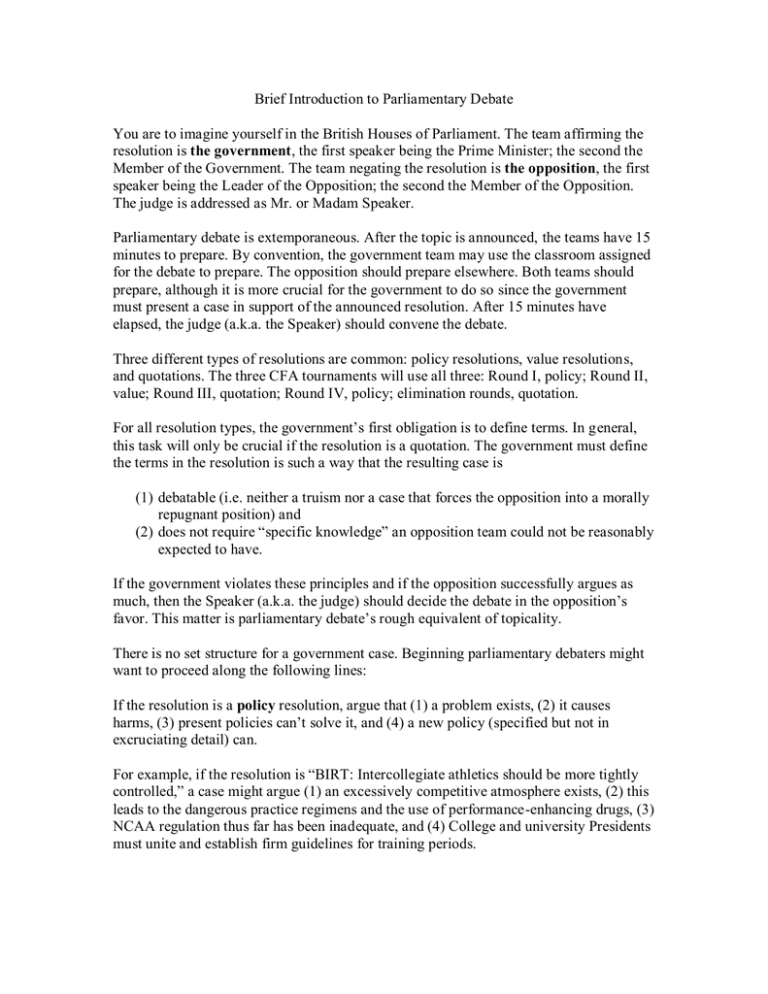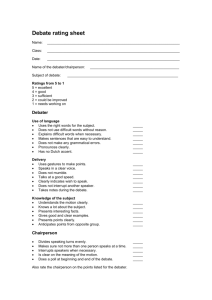Brief Introduction to Parliamentary Debate
advertisement

Brief Introduction to Parliamentary Debate You are to imagine yourself in the British Houses of Parliament. The team affirming the resolution is the government, the first speaker being the Prime Minister; the second the Member of the Government. The team negating the resolution is the opposition, the first speaker being the Leader of the Opposition; the second the Member of the Opposition. The judge is addressed as Mr. or Madam Speaker. Parliamentary debate is extemporaneous. After the topic is announced, the teams have 15 minutes to prepare. By convention, the government team may use the classroom assigned for the debate to prepare. The opposition should prepare elsewhere. Both teams should prepare, although it is more crucial for the government to do so since the government must present a case in support of the announced resolution. After 15 minutes have elapsed, the judge (a.k.a. the Speaker) should convene the debate. Three different types of resolutions are common: policy resolutions, value resolutions, and quotations. The three CFA tournaments will use all three: Round I, policy; Round II, value; Round III, quotation; Round IV, policy; elimination rounds, quotation. For all resolution types, the government‟s first obligation is to define terms. In general, this task will only be crucial if the resolution is a quotation. The government must define the terms in the resolution is such a way that the resulting case is (1) debatable (i.e. neither a truism nor a case that forces the opposition into a morally repugnant position) and (2) does not require “specific knowledge” an opposition team could not be reasonably expected to have. If the government violates these principles and if the opposition successfully argues as much, then the Speaker (a.k.a. the judge) should decide the debate in the opposition‟s favor. This matter is parliamentary debate‟s rough equivalent of topicality. There is no set structure for a government case. Beginning parliamentary debaters might want to proceed along the following lines: If the resolution is a policy resolution, argue that (1) a problem exists, (2) it causes harms, (3) present policies can‟t solve it, and (4) a new policy (specified but not in excruciating detail) can. For example, if the resolution is “BIRT: Intercollegiate athletics should be more tightly controlled,” a case might argue (1) an excessively competitive atmosphere exists, (2) this leads to the dangerous practice regimens and the use of performance-enhancing drugs, (3) NCAA regulation thus far has been inadequate, and (4) College and university Presidents must unite and establish firm guidelines for training periods. If the resolution is a value resolution, argue that (1) whatever possesses a certain quality is to be preferred, (2) x possesses that value, and (3) the alternative y does not. For example, if the resolution is “BIRT: Isolationism is the best foreign policy for the United States,” a case might argue (1) the safety of the American people should be the paramount goal of foreign policy; (2) isolationism, insofar as it keeps the nation out of entanglements that could lead to war or prompt acts of terror against us, best serves the goal of safety, and (3) any form of engagement, even if labeled “constructive,” could prove dangerous and, thus, a threat to safety. If the resolution is a quotation, define terms, restate resolution with definitions in mind, and offer a set of arguments in support of the resolution. Teams oftentimes try to offer arguments of different sorts—perhaps, political, economic, and philosophical. For example, if resolution is “BIRT: „Who let the dogs out,” the government would note that dogs are supposed to be docile but can turn vicious if not treated right. Based on this sense of “dogs,” the government would define “dogs” as male juveniles and argue that many have turned to crime because they have been exposed to too much media violence, have gotten involved in gangs, and have lacked strong male role models while growing up. The case would argue that “We” let the dogs out by (1) countenancing violent media, (2) not effectively addressing the problems posed by urban gangs, and (3) not effectively addressing the problems posed by fatherless homes. The case would call for action but would not have to specify what kind. Evidence per se is not used in parliamentary debate. However, a good parliamentary debate is not assertions and counter assertions. Debaters are expected to play off of what they‟ve learned in courses, read in newspapers and news magazines, and heard on television. In general, arguments are developed in a good parliamentary debate in the same ways they are in extemporaneous and impromptu speaking. Now . . . onto the debate itself. There are four constructive speeches: Prime Minister: 7 minutes Leader Opposition: 8 minutes Member of Government: 8 minutes Member of Opposition: 8 minutes The Prime Minister presents the Government‟s case. The Leader of Opposition refutes that case: this refutation ideally mixes point-by-point argumentation and independent argumentation establishing why the Government‟s case should not be accepted. The Member of the Government should rebuild the Government‟s case and refute all arguments offered by the opposition. This speaker may initiate new arguments in support of the government‟s case. The Member of the Opposition should refute anything that was new in the MG‟s speech. Then, the MO should advance the position the opposition has offered by (1) returning to LO arguments and reinforcing them and (2) advancing new arguments against the government‟s case. After these constructive speeches, there are but two rebuttals: the Leader of Opposition sums up the debate for the Opposition in 4 minutes; the Prime Minister sums up the debate for the opposition in 5 minutes. In general, the LO should highlight those arguments he/she believes will defeat the case. The PM, on the other hand, should rebuild the case and refute those arguments against the case that he/she judges to be crucial. Parliamentary debate is highly interactive. Debaters may rise during a debate to offer a point of order, a point of personal privilege, or a point of information. Debaters may also heckle. They finally may offer verbal evidence of their pleasure or displeasure—e.g. desk-thumping, shouts of “here, here,” boos, and hisses. A point of order is permissible at any time when the debater speaking violates the rules of “the House.” However, in NPDA competition, such points are rare. Probably the only occasion for one would be if a debater introduces an entirely new line of argumentation in the rebuttals. A point of personal privilege is also permissible at any time. Although relatively rare in NPDA competition, they can be used when a debater believe he/she has been misquoted by the person speaking or when a debater believes he/she has been personally insulted or offended by the person speaking. For example, if the person speaking implies an opponent lacks intelligence or makes comments that reflect sexism or racism. Points of order and personal privilege work the same way. A debater rise saying, “I rise on a point of _____.” The Speaker of the House says, “State your point,” and the debater who rose succinctly states it. Then, the Speaker of the House rules that the point is welltaken, not well-taken, or taken under advisement. Note that the person who was debating says nothing! The clock is stopped during this exchange. If a point is well-taken, it is incumbent upon the person who was debating to respond appropriately—to drop the argument if it has been judged new; to apologize if judged to be misrepresenting or offending an opponent. A point of information is permissible only during constructive speeches and not in these speeches initial or final minute. A point of information should be a brief question. It is usually asked to either clarify or to undermine what the person speaking is saying. Conventionally, a debater rises on a point of information signaling in some way that he/she has a question. It is up to the person speaking to decide whether or not to take the question. In general, it is bad form to reject all points but bad debating to accept all since the time they take comes out of the speaker‟s allotted 7 or 8 minutes. A good debater will respond to the point quickly and move on. A heckle is permissible at any time, although courtesy suggests that speakers not be heckled when they are in the final minute of a speech. A heckle, by definition, is a brief, witty, substantive remark interjected into the debate by a seated debater. A good debater will respond briefly to a heckle and move on, although heckles can be ignored and in some cases best are. Two other matters might be mentioned: “canned cases” and “time-space cases.” “Canned cases” are pre-prepared. They run contrary to the spirit of parliamentary debate and are, therefore, frowned upon. Nonetheless, they exist. They seem to surface more when the resolution is a quotation. Debaters offering a “canned case” will often define the terms in the quotation ingeniously so that the pre-prepared case fits. The best response to such a use of a “canned case” is to challenge the link the government has offered between the resolution and the case. If the opposition can demonstrate that the link is tenuous, then it can win the debate on that issue alone. “Time-space cases” put all the debaters in a time and/or place different from the one they are really in. Once placed, debaters must live with the limitations of that placement. For example, if one is placed in 1800, one cannot talk about things that have happened or developed since 1800. “Time-space” cases can prompt interesting debates. For example, a Smith team once took us the Princeton opposition back to the end of the 5 th Day of Creation and argued that God ought to create men and women at the same time. In general, NPDA circuit judges have frowned on them, making them progressively less and less common. AND to judges who are reading this: As with any form of debate, you judge a parliamentary round based on what happened during in it. Any predispositions one way or the other on the topic should not enter into one‟s decision. A judge should ask which team did the better job of persuading him/her. In asking this question, a judge should recognize that in parliamentary debate both arguments and the various aspects of delivery should be recognized as contributing to the persuasiveness of debaters‟ performance.




